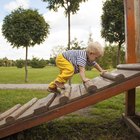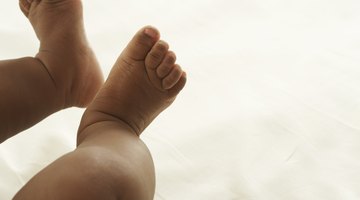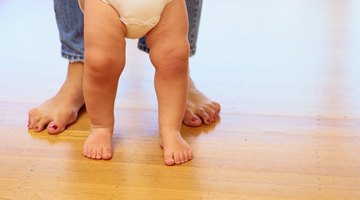Large Muscle Development in Infants
At birth, infants have no control over their muscle responses. However, infants are born with reflexes, an automatic muscle response to a specific stimulus, such as the rooting and sucking reflex, that allows them to feed, and the "Moro" reflex that causes the infant to startle in the presence of a loud noise.
Muscle development in infants can be uneven, and some babies develop their skills faster than others. Even with individual differences in development though, "Physical development is orderly and occurs in predictable sequence," beginning with control of the head and the trunk, according to Novella J. Ruffin, Extension Child Development Specialist at Virginia State University.
Large Muscle Skills
Large muscle skills are also called gross motor skills. Large muscles control the legs, arms, back and shoulders. In Infants, these muscles are used for skills such as rolling over, crawling, sitting, and eventually pulling himself up and walking.
Birth to 3 months

Development of Depth Perception in Infants
Learn More
In the first three months of life, an infant's main large muscle development is the control of his head, neck and chest. Withing the first few months, babies will gain the strength and skill to hold their heads up and face straight ahead while on their backs. During these early months, infants also start to follow a moving object by moving their head from side to side and lift their heads up while on their stomach.
In the first three months, much of an infant's leg and arm movement in involuntary. However, they start to gain control over these movements and begin to hold onto a toy that is placed into their hands.
4 to 6 Months
Between four and six months of age, an infant's large muscle movement becomes much more purposeful. He will begin to rake at objects with his fingers, grasp toys and bring them to his mouth. Most babies this age raise their heads when lying facedown. Their leg and arm movements will lead to them to push off the floor and roll themselves over. By the end of six months of age, some babies are able to sit without support and may even start to bear weight on their legs.
7 to 9 Months

Developmental Milestones Related to Climbing
Learn More
Between the seventh and the ninth month, most babies can roll over in both directions. They should have developed the arm muscle control needed to move and object from one hand to the other, and fine muscle development increases.
Many babies this age are able to sit without support and some are already crawling well. Some babies are even developing leg muscle control and can stand holding onto furniture, and some are ready to cruise by holding onto large objects.
10 to 12 Months
Between 10 and 12 months, infants are working on mastering large muscle control. According to MayoClinic.com "Most babies this age can sit without help and pull themselves to a standing position." Crawling and cruising will eventually lead to walking, and by 12 months, many babies will take their first steps.











